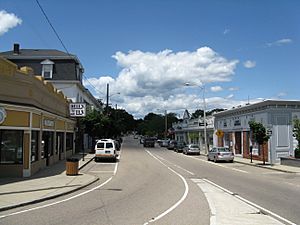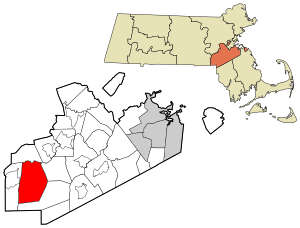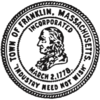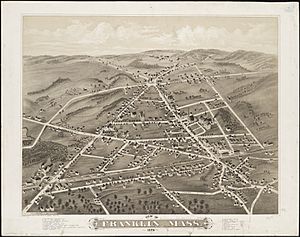Franklin, Massachusetts facts for kids
Quick facts for kids
Town of Franklin
|
||
|---|---|---|

Main Street in 2010
|
||
|
||
| Motto(s):
Industry Need Not Wish
|
||

Location in Norfolk County in Massachusetts
|
||
| Country | ||
| State | ||
| County | Norfolk | |
| Settled | 1660 | |
| Incorporated | 1778 | |
| Government | ||
| • Type | Council-manager | |
| Area | ||
| • Total | 27.03 sq mi (70.00 km2) | |
| • Land | 26.64 sq mi (68.99 km2) | |
| • Water | 0.39 sq mi (1.01 km2) | |
| Elevation | 300 ft (91 m) | |
| Population
(2020)
|
||
| • Total | 33,261 | |
| • Density | 1,248.58/sq mi (482.08/km2) | |
| Time zone | UTC−5 (Eastern) | |
| • Summer (DST) | UTC−4 (Eastern) | |
| ZIP Code |
02038
|
|
| Area code(s) | 508/774 | |
| FIPS code | 25-25100 | |
| GNIS feature ID | 0611686 | |
The Town of Franklin is a city in Norfolk County, Massachusetts, United States. Even though it's called a "Town," it actually has a city-style government. This is because Franklin, like twelve other places in Massachusetts, chose to keep "Town of" in its name even after becoming a city.
In 2022, about 36,745 people lived here. Franklin is famous for being home to America's first public library. This library, the Franklin Public Library, opened in 1790. Its first books were a gift from Benjamin Franklin himself! Franklin also has St. Mary's Catholic Church, which is the largest Catholic church in the Boston area. It has about 15,000 members.
Contents
History of Franklin
Europeans first settled in the area that is now Franklin in 1660. The town was officially created during the American Revolution on March 2, 1778. It was formed from the western part of Wrentham.
The people of the town wanted to name it Franklin. They chose this name to honor the famous statesman Benjamin Franklin. It was the very first place in the United States to be named after him!
The town hoped Benjamin Franklin would donate a bell for their church. Instead, he sent 116 books! These books included Night-Thoughts and works by John Locke. On November 20, 1790, the town decided to let people borrow these books for free. This started the Franklin Public Library. It is the oldest public library in the nation that has been open continuously. The beautiful Ray Memorial Library building was opened in 1904.
Franklin is also the birthplace of Horace Mann. He is known as the "father of public education" in America. The town was also home to the Red Brick School. This school might have been the oldest continuously running one-room schoolhouse in the country. It started in 1792 and was used until 2008.
Geography and Nature
Franklin is located at 42°5′N 71°24′W / 42.083°N 71.400°W. The town covers about 27 square miles (70 square kilometers). Most of this area is land, with a small part being water.
A lot of Franklin is part of the Charles River area. Important streams here include Mine, Shepard's, Miller, Uncas, Dix, and Miscoe Brooks. Many marshy areas along Mine Brook are protected. They are part of the Natural Valley Storage Project. This project helps control floods.
The southwestern part of Franklin is in the Blackstone River area. Franklin also has a series of lakes called the Franklin Reservoir. These lakes are not used for drinking water. They are now protected as open space for nature.
Ernest DelCarte (1911–2000) gave land to the Town of Franklin. This land became the DelCarte Recreation and Conservation Area. The DelCarte family helped make sure the land would stay as open space. This area was worth about $3 million when it was given to the town. It received a big upgrade in 2014. Franklin also has large public forests and parks. These include the Franklin State and Franklin Town Forests.
Weather in Franklin
| Climate data for Franklin, MA (1991-2020, coordinates:41°04′45″N 71°24′34″W / 41.0792°N 71.4094°W) | |||||||||||||
|---|---|---|---|---|---|---|---|---|---|---|---|---|---|
| Month | Jan | Feb | Mar | Apr | May | Jun | Jul | Aug | Sep | Oct | Nov | Dec | Year |
| Average precipitation inches (mm) | 3.95 (100) |
3.51 (89) |
4.73 (120) |
4.51 (115) |
3.58 (91) |
4.45 (113) |
3.63 (92) |
3.86 (98) |
4.11 (104) |
4.93 (125) |
4.08 (104) |
4.92 (125) |
50.26 (1,276) |
| Average snowfall inches (cm) | 10.4 (26) |
14.9 (38) |
10.7 (27) |
1.2 (3.0) |
0.0 (0.0) |
0.0 (0.0) |
0.0 (0.0) |
0.0 (0.0) |
0.0 (0.0) |
0.2 (0.51) |
1.4 (3.6) |
8.9 (23) |
47.7 (121.11) |
| Average precipitation days (≥ 0.01 in) | 10.7 | 9.0 | 10.6 | 11.3 | 12.3 | 11.3 | 9.9 | 9.3 | 9.0 | 11.3 | 9.8 | 10.8 | 125.3 |
| Average snowy days (≥ 0.01 in) | 4.5 | 3.8 | 2.8 | 0.3 | 0 | 0 | 0 | 0 | 0 | 0 | 0.5 | 2.6 | 14.5 |
| Source: NOAA | |||||||||||||
People of Franklin
| Historical population | ||
|---|---|---|
| Year | Pop. | ±% |
| 1850 | 1,810 | — |
| 1860 | 2,172 | +20.0% |
| 1870 | 2,512 | +15.7% |
| 1880 | 4,051 | +61.3% |
| 1890 | 4,831 | +19.3% |
| 1900 | 5,017 | +3.9% |
| 1910 | 5,641 | +12.4% |
| 1920 | 6,497 | +15.2% |
| 1930 | 7,028 | +8.2% |
| 1940 | 7,303 | +3.9% |
| 1950 | 8,037 | +10.1% |
| 1960 | 10,530 | +31.0% |
| 1970 | 17,830 | +69.3% |
| 1980 | 18,217 | +2.2% |
| 1990 | 22,095 | +21.3% |
| 2000 | 29,560 | +33.8% |
| 2010 | 31,635 | +7.0% |
| 2020 | 33,261 | +5.1% |
| 2022 | 33,656 | +1.2% |
| * = population estimate. Source: United States Census records and Population Estimates Program data. Source: |
||
In 2010, there were 31,852 people living in Franklin. About 10,866 households and 7,877 families called Franklin home. The population density was about 1,105 people per square mile.
Most people in Franklin (92.8%) were White. About 3.83% were Asian or Pacific Islander. About 2.0% were Hispanic or Latino. And 1.4% were Black or African American.
Many households (44.6%) had children under 18 living with them. The average household had 2.80 people. The average family had 3.29 people.
About 28.5% of the population was under 18 years old. The median age in Franklin was 35 years. This means half the people were younger than 35 and half were older.
The median income for a household in Franklin was $92,066. This means half of the households earned more than this, and half earned less. About 3.6% of all people in Franklin lived below the poverty line. This included 2.8% of those under 18.
Many Franklin residents (65.5%) say they are religious. Of these, 54.2% are Catholic. Other religions include Jewish, Presbyterian, and Episcopalian. Smaller groups include Baptist, Lutheran, Methodist, Buddhist, Pentecostal, Mormon, Hindu, Mennonite, and Muslim faiths.
Education in Franklin
Franklin has a good school system. It includes five elementary schools for grades K-5. There are four middle schools for grades 6-8. And there is one high school for grades 9-12. The town also has a charter school for grades K-8.
Elementary Schools (Grades K–5):
- John F. Kennedy Memorial School
- Gerald M. Parmenter Elementary School
- Oak Street Elementary School
- Helen Keller Elementary School
- Jefferson Elementary School
- The Red Brick School is a historic building in town. It was one of the longest-running one-room schools in the USA.
- Benjamin Franklin Classical Charter Public School (K-8)
Middle Schools (Grades 6-8):
- Horace Mann Middle School
- Annie Sullivan Middle School
- Remington Middle School
- Benjamin Franklin Classical Charter Public School (K-8)
High Schools (Grades 9–12):
- Franklin High School built a new school building in 2014.
- Tri-County Regional Vocational Technical High School is also nearby. It accepts students from Franklin and other towns.
Franklin is also home to Dean College. This is a private college founded in 1865. It has over 1,100 students. Dean College offers two-year (associate) degrees. Most students then transfer to four-year schools. It also has four-year (bachelor's) programs. These include subjects like Business, Psychology, and Dance.
Fun Places to Visit
The Franklin Public Library is a very special place. It was America's first public library! The original books were given by Benjamin Franklin. Right across the street from the library is Dean College.
At one end of Franklin's Historic District, you can find the little Red Brick School. Its classroom is thought to be one of the oldest public schools in the United States. It is not used as a school anymore. In 2008, it celebrated its 175th birthday!
Getting Around Franklin
Franklin has two exits on I-495. These are at Route 140 and King Street. You can also travel by train using the MBTA Commuter Rail. The Franklin/Foxboro Line stops at [[{{{station}}} (MBTA station)|{{{station}}}]] and [[{{{station}}} (MBTA station)|{{{station}}}]]. Franklin is also part of the GATRA bus service area. This means you can get rides on demand.
Famous People from Franklin
- Charles Partridge Adams, landscape painter
- Asa Aldis, Chief Justice of the Vermont Supreme Court
- Maria Barrett, US Army Major General
- Edward Reed Blake, Wisconsin state legislator
- Bernard Davis, biologist
- Oliver Dean, physician and founder of Dean College
- Nathanael Emmons, minister and theologian
- George Warren Fuller, innovator in water treatment
- Eddie Grant, baseball player
- Richard Grieco, actor
- Murray Hill, comedian
- Kristi Kirshe, rugby player
- Peter Laviolette, ice hockey coach
- Paula Lodi, US Army Brigadier General
- Horace Mann, educator
- Theron Metcalf, Massachusetts Supreme Judicial Court Justice
- Robbie O'Connell, folk singer
- Jen O'Malley Dillon, political strategist
- Albert D. Richardson, journalist and author
- Jermaine Samuels, basketball player
- Bobby Santos III, NASCAR driver
- Ilario Zannino, former resident of Franklin
See also
 In Spanish: Franklin (Massachusetts) para niños
In Spanish: Franklin (Massachusetts) para niños




